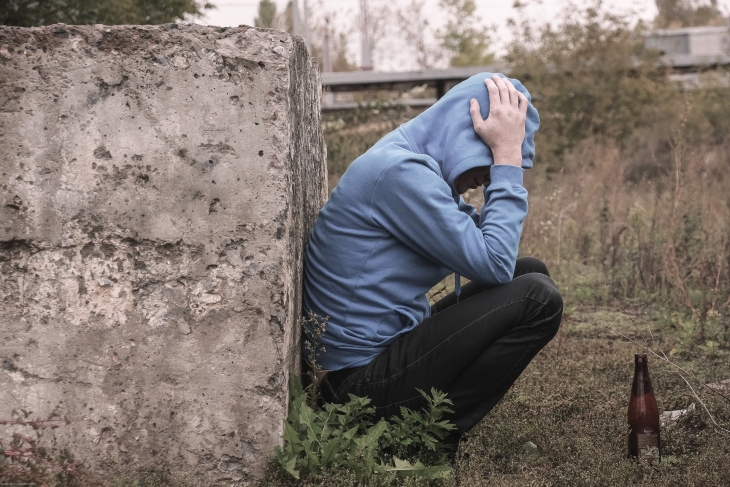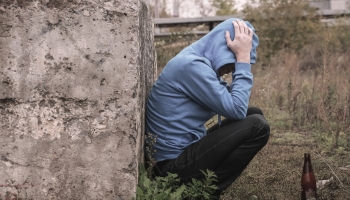
What causes addiction? Can you become addicted to drugs after just one use, or is addiction passed down through our genes? There are roughly 22.7 million Americans who suffer from substance use disorders, but not all cases can be traced back to just one cause. In reality, there are countless reasons a person might suffer from addiction.
Environment, genetics, and mental illness are just some common causes of addiction in our society. Addiction is often unintentional, and can even happen when someone accidentally misuses prescription drugs.
Understanding how addiction works can help remove the stigma surrounding this brain disorder, and encourage millions of Americans to seek treatment. Presently, only 2.5 million people who suffer from addiction are receiving treatment for their conditions.
Here’s an in-depth look at what causes addiction. Review this information so you and your loved ones can be aware of common causes of addiction, and seek treatment when needed.
Addiction in the U.S.
Alcohol is the most commonly abused substance in the U.S., followed by marijuana. There are roughly 17.3 million Americans with alcohol use disorder, and 4.2 million Americans with marijuana use disorder. Marijuana is legal for medicinal and recreational use in many states, but remains an illicit substance on the federal level.
Opioid addiction is one of the biggest problems America is facing as a whole. Opioid addiction affects roughly 2.5 million Americans, and caused more than 33,000 overdose deaths in 2015. In 2016 the opioid overdose death toll jumped to over 53,000, and is projected to be even higher by the end of 2017.
President Trump recently declared the U.S. opioid epidemic a public health emergency, which means extra federal funds will be awarded to states being strongly impacted by opioid addiction. The Trump Administration is currently working with healthcare officials to provide telemedicine to those in isolated and rural areas, and to speed up the hiring process of nurses, doctors, and other healthcare workers who can work toward improving the opioid epidemic.
Addiction treatment centers are located all throughout the country to help Americans become healthier and addiction-free. But sadly, less than one percent of the U.S. population who suffer from addiction are receiving professional treatment.
Defining Addiction
Many Americans loosely define addiction as a condition in which one cannot control their urges to abuse alcohol and drugs. But the science of addiction and substance use disorders is much more complex, and can be triggered by any one or combination of factors. Addiction is most commonly caused by physical and psychological changes that occur in the body and brain on behalf of drug and alcohol abuse.
The National Institute of Drug Abuse defines addiction as a chronic relapsing brain disease. Addiction is marked by a compulsive need to use drugs and alcohol despite negative consequences. Drugs and alcohol can cause long-term changes to the brain’s structure and functionality, and increase the risk for mental illness and behaviors that could lead to major life problems with one’s career, finances, and more.
Though addiction is most commonly associated with alcohol and drug use, some addiction types are purely behavioral and do not involve the use of substances — such as gambling addiction, shopping addiction and video game addiction. A person who abuses drugs and alcohol can become physically dependent on these substances due to the way they alter brain function. Dependence occurs when a person’s body becomes adapted to the presence of drugs and alcohol, and requires or “craves” a certain amount to avoid withdrawal symptoms.
Leading Causes of Addiction

Early exposure to drugs or alcohol increases your risk for addiction.
Addiction affects everyone differently, and can be caused by a wide range of factors. Addiction can be caused by growing up in an environment surrounded by drugs and alcohol, or can be caused by accidentally taking the wrong dose of prescription drugs. Some may become addicted to alcohol as a result of drinking every day to relieve stress, while others may suffer from mental health disorders that influence them to try dangerous substances.
Here are leading causes of addiction in the U.S., and how these factors commonly lead to substance use disorders.
1. Genetics
People who suffer from addiction can attribute as much as 50 percent of their addiction to genetics. Those with parents or grandparents who suffered from substance use disorders are more predisposed to addiction than those without addiction in their family backgrounds. Any person who struggles with addiction can pass this disease onto their children and grandchildren via DNA.
Scientists have not been able to identify any one gene as the “addiction” gene, but continue conducting ongoing studies to establish a solid link between genetics and addiction. Many times, researchers will study DNA from all members of a large family to look for shared genes that may indicate the presence of addiction.
Those with a family history of addiction are often encouraged to abstain from using drugs and alcohol to lower their risk for this disease. Recognizing genetics as a common cause of addiction can help families stay safe from addiction.
2. Environment
Have you ever heard the saying, “You are a product of your environment?” A person’s environment plays a major role in their risk for addiction. Common environmental risk factors that are linked to an increased risk for addiction are home, family, friends, community, and school.
People who spend time in environments that encourage alcohol and drug use are more likely to suffer from addiction than their counterparts. For instance, a person who grows up surrounded by family who drinks excessive amounts of alcohol every night may also begin consuming alcohol in the same manner.
Children, teens, and young adults aren’t the only age groups affected by environment when it comes to addiction. Anyone who spends time in settings that promote drug use or view this behavior as “normal” are at higher risk for suffering addiction regardless of age, education, income level, and other socioeconomic factors.
3. Exposure at a Young Age
Research shows that the earlier a person is exposed to drugs, the more likely they are to suffer from addiction later in life. A recent study in particular found that roughly 74% of adults between the ages of 18 and 30 who suffer from addiction had initially started using drugs at the age of 17 or younger. Just over 10 percent of those involved in the study started using drugs at age 11 or younger.
Scientists believe that exposure and experimentation at an early age can have harmful effects on a youth’s developing brain that increase the risk for addiction. Early exposure is also linked closely to environment, since youth who spend lots of time in environments with access to drugs and alcohol are more likely to start using these substances.
4. Brain Structure Rewiring
Drugs and alcohol bind to receptors in the brain that are responsible for controlling feelings of pain, pleasure, and reward. Each substance affects the brain differently based on its chemical makeup. For example, opioids like heroin and oxycodone bind to opioid receptors in the brain that alter the way the brain perceives pain, as well as the way it experiences feelings of pleasure and reward.
Dopamine is a brain chemical responsible for controlling feelings of pleasure and reward. A person’s brain naturally releases dopamine when they experience a rewarding, fulfilling moment, such as earning a promotion at work or spending time with a loved one. But drugs and alcohol flood the brain with excess dopamine — influencing users to keep coming back for more to achieve a state of heightened euphoria.
Repeated use of drugs and alcohol can rewire the brain and alter normal brain function. For many years, people believed one could become addicted to drugs after just one use. But substance abuse is a behavior that when practiced regularly, can greatly increase the risk for addiction.
5. Mental Health Disorders
Roughly 50 percent of all people who suffer from mental health disorders also suffer from addiction, and vice versa. Mental illness and addiction are strongly linked on behalf of the way each disorder causes long-term changes to the brain.
Those who suffer mental illness often use drugs and alcohol to mask or cope with their emotions and symptoms. For instance, a person who suffers social anxiety disorder may use alcohol to help them feel more open and sociable with others. A person who suffers bipolar disorder may experiment with dangerous, potent drugs like cocaine or heroin during episodes of mania when behavior is affected by poor judgement and impulsivity.
At the same time, addiction can often lead to mental illness on behalf of regular, repeated drug use. When the brain becomes dependent on drugs, it stops producing dopamine — the chemical responsible for a person’s feelings of reward and happiness. When a person suddenly stops using drugs, they may suffer from depression or anxiety since drugs are not being supplied to the body to lift their moods.
6. Other Common Causes of Addiction
Trauma, high stress levels, and method of drug use are other common causes of addiction. Those who have suffered psychological trauma, or physical trauma and injury are highly likely to suffer from addiction, as are those who suffer from chronic stress. The drugs a person uses and method of administration are also common risk factors.
Heroin, cocaine, and crystal meth are the most addictive drugs in the world due to the way these substances alter the brain and quickly lead to tolerance and physical dependence. Smoking or injecting drugs also increases their addictive potential, since these methods allow drugs to reach the brain even faster. In the U.S., painkiller addiction is at an all-time high on behalf of the opioid epidemic, and is said to be caused by prescription drug abuse and the overprescribing of opioids by doctors.
How to Prevent Addiction
One of the top ways to prevent addiction is to avoid starting young, and educate children and youth about the dangers and risks surrounding drug use. Addiction treatment experts recommend that U.S. schools and communities use research-based prevention programs to educate American youth, since implementation of these programs have been proven effective at reducing drug and alcohol use across U.S. communities.
Here are other ways to prevent addiction in your family and community:
- Limit time spent with negative influences who have favorable attitudes toward alcohol and drug use.
- Find new, healthy ways to manage stress, such as exercise and relaxation techniques.
- Seek treatment for existing mental illness to lower the risk for addiction.
- Familiarize yourself with common signs and symptoms of substance abuse.
- Overcome past trauma through counseling, support groups, and other professional therapies.
- Build a strong, supportive network of caring friends and family who can deter you from substance abuse.
- Get help immediately if you or a loved one is experiencing symptoms of dependency and withdrawal to prevent a full-blown addiction.
Finding Addiction Treatment
Substance use disorders and addiction can be safely and effectively treated at one of thousands of addiction treatment centers across the U.S. Inpatient drug rehab centers are often the best course of treatment for those who suffer from addiction, since these facilities offer around-the-clock care in safe, stable environments away from negative influences.
Inpatient rehab centers treat drug and alcohol dependence using detoxification, or detox. With inpatient care, patients withdraw from drugs and alcohol surrounded by caring, attentive medical staff, and may be prescribed medications to reduce or completely relieve their painful withdrawal symptoms.
After going through detox, patients can start receiving therapy to overcome psychological causes of addiction such as trauma and mental illness. Behavioral therapy in the form of support groups and individual, group, and family counseling help patients identify the real root causes of their addiction so they can move forward with healing. Inpatient rehab centers also offer continuing care programs to help patients stay addiction-free during the months and years after achieving sobriety.
